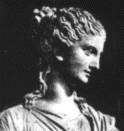

Me vero primum dulces ante omnia Musae,
quarum sacra fero ingenti percussus amore,
accipiant caelique vias et sidera monstrent,
defectus solis varios lunaeque labores ...
Verg., Georg., II, 475-478
 With these words Virgil invokes the Muses, that they may disclose the
secrets of the sky, the eclipses and the phases of the moon: this particular
task is traditionally set to
Urania, Muse of Astronomy. She is the one who
elevates man's thought from terrestrial to celestial objects, giving him
harmony and peace.
With these words Virgil invokes the Muses, that they may disclose the
secrets of the sky, the eclipses and the phases of the moon: this particular
task is traditionally set to
Urania, Muse of Astronomy. She is the one who
elevates man's thought from terrestrial to celestial objects, giving him
harmony and peace.
Two are the main versions of the myth of Urania, deity who derives her name from Ouranos (sky): according to the Herodotean tradition she is daughter of Sky and Light, corresponding to the Assyrian Mylitta, to the Phoenician and Carthaginian Ashera (Astaroth), to the Arabian Alilat (from the Arabic a-lilat = night) and to the Scythian goddess Artimpara. This tradition identifies Urania with Aphrodites Urania, or celestial Venus; Hesiod probably knew the oriental tradition himself, as he refers to Aphrodite as Uranus' daughter ( Theog., 989).
In the best known tradition Urania is the Muse of astronomy, although she does not appear among the three Muses originally mentioned by Pausanias and Varro: daughters of the Sky, worshipped on the Helicon by the Aloades, they are called Meléte, Mneme and Aoidé. Their names refer to the fundamental components of poetry: meditation, memory and song. Cicero mentions four Muses: Telsiopes, Aoidé, Mneme and Meléte. In Varro's account the number of nine was reached when three sculptors made three statues of the Muses each, to be placed in Apollo's sanctuary. The statues being all so undoubtedly fine and precious, the clients could not choose among them and kept all the nine Muses. Diodorus Siculus wrote that Osiris used to be followed by musicians and dancers, among which nine sisters and a brother excelled, so that they were called Muses and Musagetes.
The Greek mythology, in Hesiod's systematization (Theog., 75-103, 915-917), considers Urania as one of the nine Muses, minor deities, daughters of Zeus and of the fine-haired Mnemosyne, goddess of memory. Jupiter lay with Mnemosyne, daughter of Gaia and Uranus, during nine nights and, after one year, she gave birth to the Muses in Pieria, the region on the east slopes of Olympus. Afterwards, the nine sisters settled on the top of the Parnassus, where they lived governing the liberal arts. This was their task in the systematization of the terrestrial world achieved with the second generation of gods: the Muses, endowed with grace and musical spirit, dispense harmony and peace singing the anthem of the victorious Olympians after the defeat of the Titans. The myth follows a twofold tradition, according to the settlement of the Muses in Thrace (the so called Pierides, living in Pimpla), or on the Helicon, in Boeotia. While the Pierides are related to Orpheus and Dionysus' worship, the Heliconians' myth is intertwined with that of one of the major Gods, Apollo, who brings relief to the humans with his divine smile and the gift of art. When Apollo went to the Parnassus, he settled there with the nine Muses in a holy assembly devoted to the fine arts, travelling together throughout Greece on the back of Pegasus, the winged horse. Theirs was a wandering life, hence the name of Apollo Musagetes, that means he who leads the Muses. In the plastic arts the Muses are frequently represented as a choir of young women surrounding Phoebus, and only in later times they will be depicted singularly, each one with her own attributes.
In Homer's work the Muses are related to the art of foretelling, that he calls the science of good and evil, deriving the word Muse, from the Greek verb muein, (to initiate somebody to the misteries). Urania is said to inspire only chaste love, and in the classical tradition she is often depicted with her foot on a turtle, symbol of silence and retreat. Anyway Catullus, in his Carmen 61, tells that Urania gave birth to Hymenaeus, personification of the wedding hymn; Hyginus tells that a son was born, named Linus, from her supposed marriage to Apollo.



| Biblioteca del Dipartimento di Astronomia Pierluigi Battistini, Laura Peperoni e Marina Zuccoli |